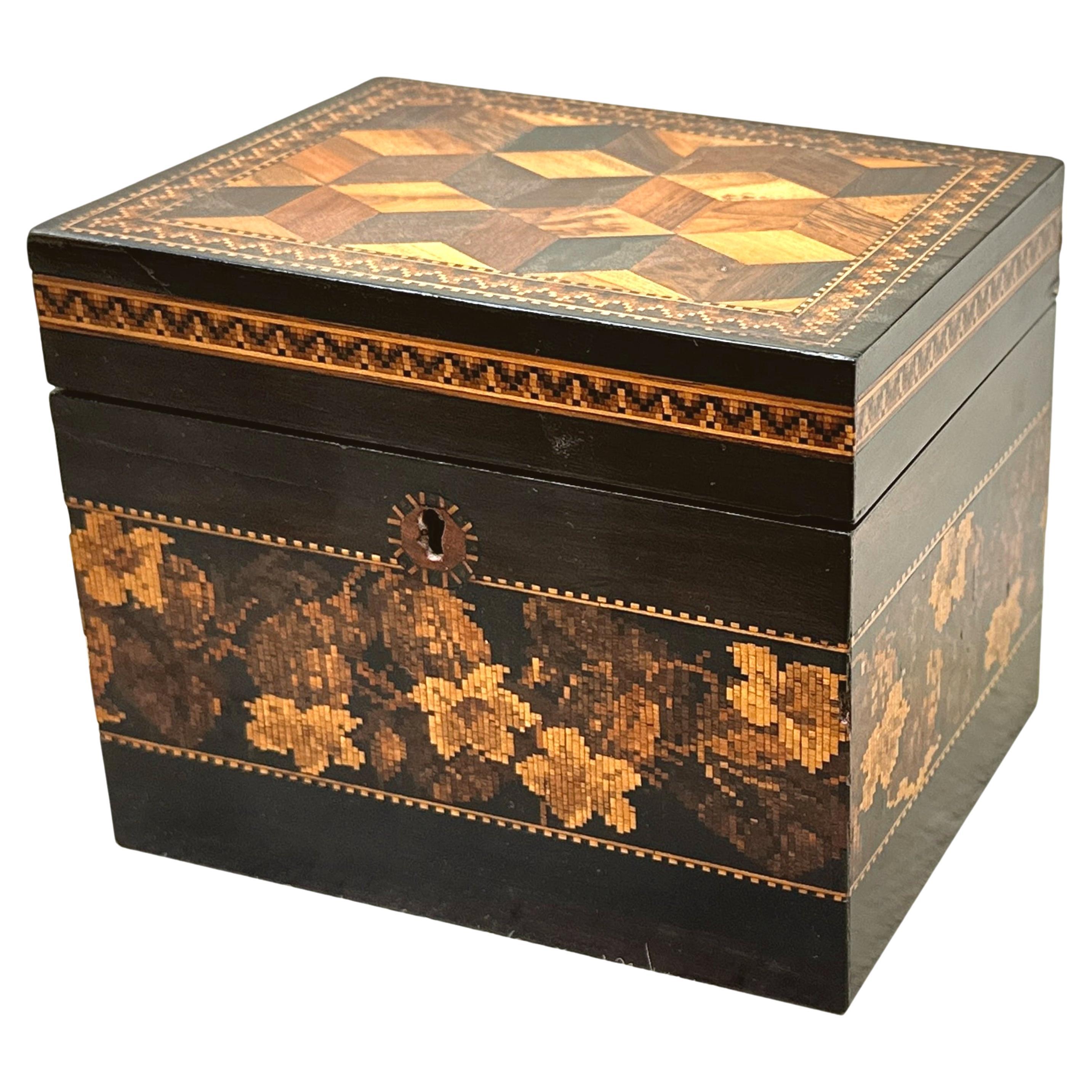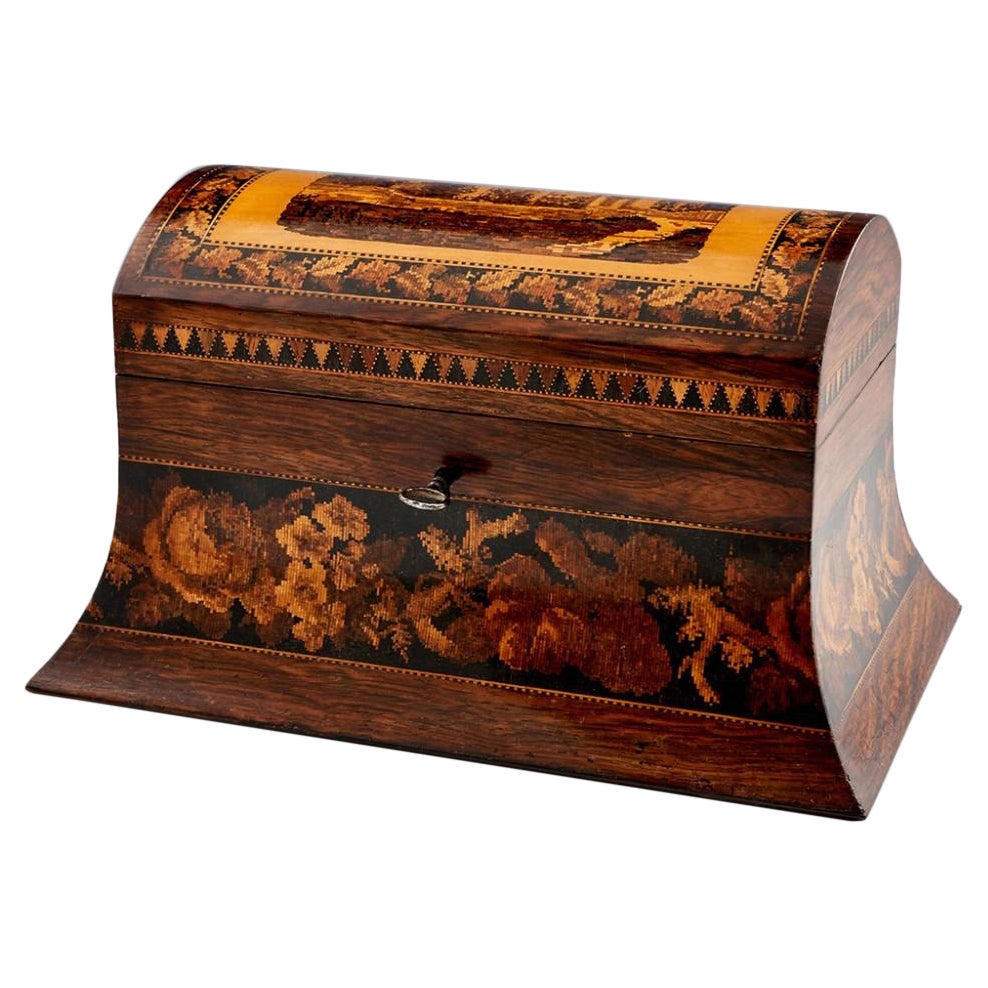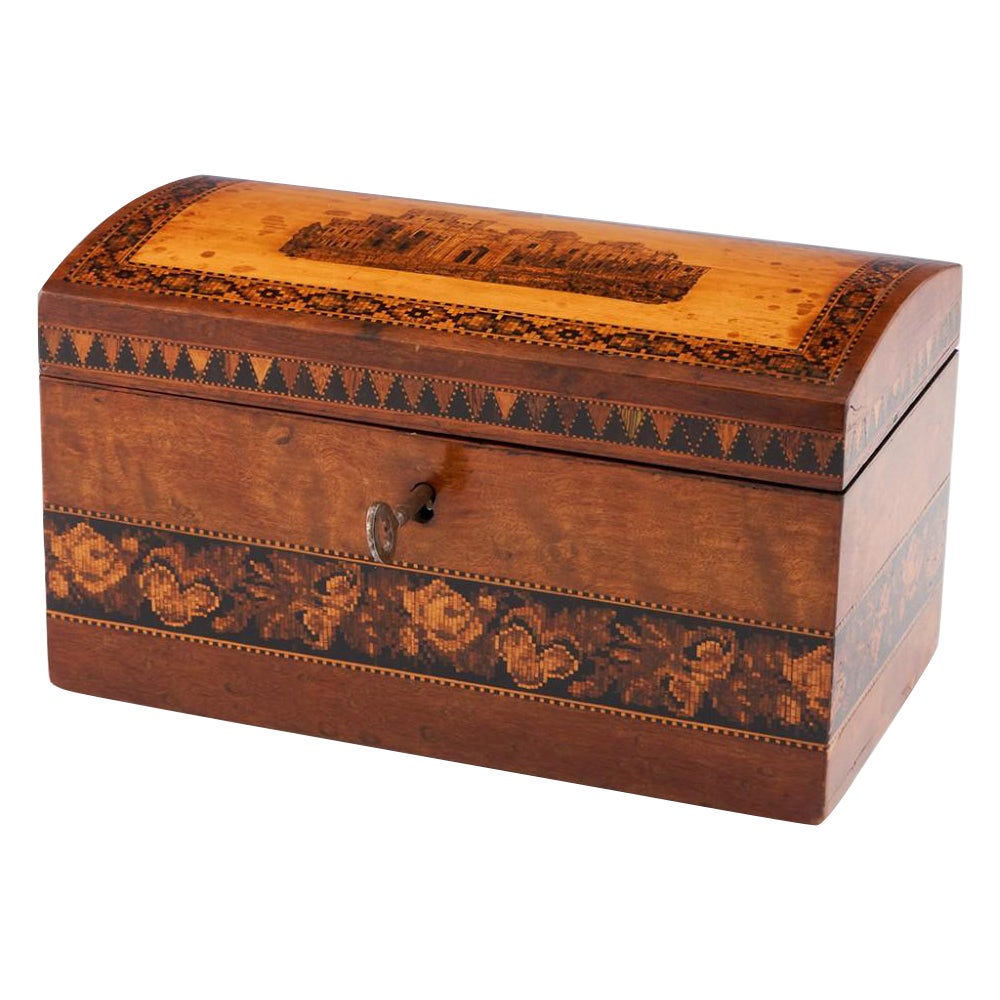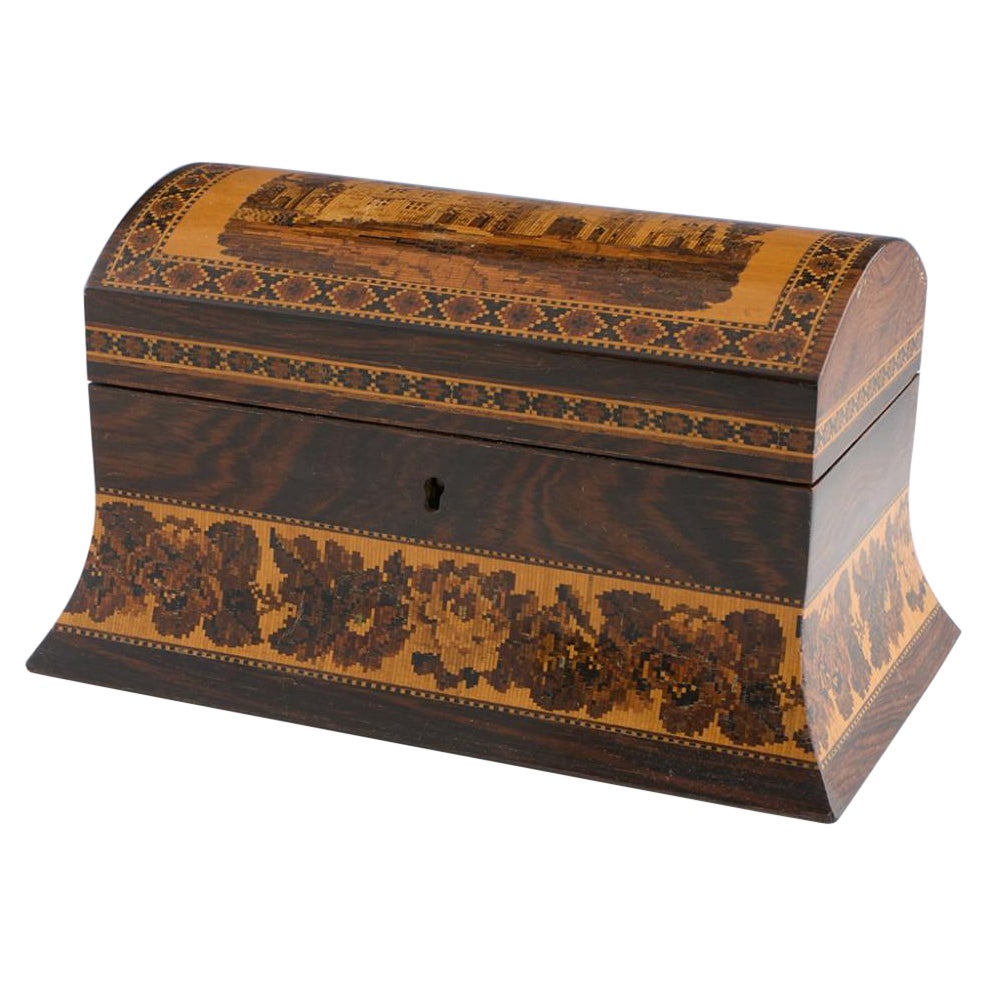Items Similar to Exceptional Tunbridge Ware Double Compartment Tea Caddy with Rare Image of Pensh
Want more images or videos?
Request additional images or videos from the seller
1 of 11
Exceptional Tunbridge Ware Double Compartment Tea Caddy with Rare Image of Pensh
About the Item
Heading : Exceptional Tunbridge ware sarcophagus double comparment & tea bowl caddy
Date : c1865
Period : Victoria
Origin : Tunbridge Wells, Kent
Decoration : Pillow topped cover. The central mosaic is of an extremely rare view of Penshurst Place's Elizabethan West face. Views of Penshurst Place are relatively rare anyway, but where they do come up they are almost always from an angle which faces the Solar and Buckingham buildings. Floral Berling woolwork border, geometric banding to side pansels of cover. The side panels of the main body have Berlin woolwork banding. Four bun feet. Internally, the compartments' covers have geometric borders. Pressed glass tea bowl.
Size : 31x15.5x17cm
Condition : Excellent, minimal wear, a small amount of lifting to the central image and only a few missing tessserae
Restoration : Two new feet
Weight : 2058 grams
As above, this is a rare view of a rarely depicted house. The image is so rare that we have been unable to find a definitive answer as to who designed it. However, given it's quality and it's similarity to other designs, we feel confident in attributing this to Henry Hollamby.
- Creator:Tunbridge Ware (Maker)
- Dimensions:Height: 6.7 in (17 cm)Width: 12.21 in (31 cm)Depth: 6.11 in (15.5 cm)
- Style:Victorian (Of the Period)
- Materials and Techniques:
- Place of Origin:
- Period:
- Date of Manufacture:1865
- Condition:Wear consistent with age and use.
- Seller Location:Tunbridge Wells, GB
- Reference Number:
About the Seller
5.0
Gold Seller
These expertly vetted sellers are highly rated and consistently exceed customer expectations.
Established in 2014
1stDibs seller since 2023
34 sales on 1stDibs
Typical response time: 5 hours
- ShippingRetrieving quote...Ships From: Tunbridge Wells, United Kingdom
- Return PolicyA return for this item may be initiated within 30 days of delivery.
More From This SellerView All
- Tunbridge Ware Two Compartment Sarcophagus Tea Caddy c1860By Tunbridge WareLocated in Tunbridge Wells, GBHeading : Tunbridge ware sarcophagus tea caddy Date : c1860 Period : Victoria Origin : Tunbridge Wells, Kent Decoration : Central floral mosaic bordered by a geometric pattern within...Category
Antique 1860s British Tea Caddies
MaterialsWood
- A Tunbridge Ware Two Compartment Tea Caddy with Rounded Lid, c1870By Henry HollambyLocated in Tunbridge Wells, GBA Tunbridge Ware Two Compartment Tea Caddy with Rounded lid Depicting Hever Castle, c1870 Additional Information: Heading: Tunbridge Ware - Two Compartment Tea Caddy with Rounded li...Category
Antique 19th Century English Victorian Tea Caddies
MaterialsLacquer
- Tunbridge Ware - A Two Compartment Tea Caddy with Eridge Castle Mosaic, c1865Located in Tunbridge Wells, GBTunbridge Ware - A Two Compartment Tea Caddy with Eridge Castle Mosaic, c1865 Additional Information: Heading: Tunbridge Ware - A Two Compartment Tea Caddy with Eridge Castle Mosaic...Category
Antique 19th Century English Victorian Tea Caddies
MaterialsSatinwood
- Two Compartment Tunbridge Ware Tea Caddy Uncommon Depiction Dover Castle, c1870By Henry HollambyLocated in Tunbridge Wells, GBTwo Compartment Tunbridge Ware Tea Caddy Uncommon Depiction Dover Castle, c1870 Additional Information: Heading: Tunbridge Ware - Two Compartment Tea Caddy with Rounded lid Depicting Dover Castle Date : c1870 Period : Victorian Origin : Tunbridge Wells; England (attrib. Henry Hollamby - see below) Decoration : The rounded and square-ended lid features a mosaic image of Dover Castle set within Golden Satinwood; it is bound by a seven-square geometric band which is in turn within sets of two continuous and one banded keyline; the flat sides of the lid have a five-square geometric band with two pairs of continuous keylines. There is a broad Berlin Woolwork...Category
Antique 19th Century English Victorian Tea Caddies
MaterialsSatinwood
- Tunbridge Ware Two Compartment Tea Caddy Depicting Battle Abbey Gatehouse c1870By Henry HollambyLocated in Tunbridge Wells, GBHeading : Tunbridge ware tea caddy depicting battle abbey gatehouse Date : c1870 Period : Victoria Origin : Tunbridge Wells, Kent Decoration : Central image depicts Battle Abbey Gate...Category
Antique 1870s British Victorian Tea Caddies
MaterialsWood
- Eridge Castle Tunbridge Ware Tea Caddy c1860By Henry HollambyLocated in Tunbridge Wells, GBHeading : Two compartment Tunbridge ware tea caddy Date : c1860 Period : Victoria Origin : Tunbridge Wells, Kent Decoration : The cover decorated with Hollamby's version of Eridge Ca...Category
Antique 1860s British Victorian Tea Caddies
MaterialsWood
You May Also Like
- Victorian Tunbridge Ware Tea CaddyLocated in Bedfordshire, GBA Charming 19th Century Tunbridge Ware Tea Caddy With Attractive Floral Band To Main Body And Parquetry Perspective Cubes To Hinged Lid Enclosing Lidded Interior. Tea was an extrem...Category
Antique Mid-19th Century English Victorian Tea Caddies
MaterialsOther
- Quality antique Victorian tunbridge ware inlaid tea caddyLocated in Ipswich, GBQuality antique Victorian tunbridge ware inlaid tea caddy having a lovely antique Victorian tunbridge ware inlaid tea caddy with beautiful detail to the box opening to reveal two rec...Category
Antique Early 19th Century Victorian Tea Caddies
MaterialsWood
- 19th Century English Tunbridge Ware Marquetry Tea CaddyLocated in Forney, TXA well-made antique, circa 1830, English tea caddy with stunning marquetry inlays, warm coloring, superb detailing, and luminous rich patina! When tea first arrived in Europe in t...Category
Antique 19th Century English Regency Tea Caddies
MaterialsBrass
- Regency Tunbridge Ware Sewing BoxBy Tunbridge WareLocated in Northampton, GBFitted Interior & Silver Handles From our Tunbridge Ware collection, we are delighted to offer this Tunbridge Ware Sewing Box. The Sewing Bo...Category
Antique Early 19th Century British Regency Decorative Boxes
MaterialsSatinwood
- Brighton Pavilion Tunbridge Ware Sewing CompendiumBy Tunbridge WareLocated in Northampton, GBRare Tunbridge Ware Form Sewing Compendium From our Tunbridge Ware collection, we are delighted to offer this very rare Tunbridge Wear Sewing Compendium. The Sewing Compendium modelled as a tower from the Brighton Pavilion features the iconic minaret turned in Sycamore (aka white wood) and a large globular body with hand-painted details leading to further turned faces and the hand-painted windows upon a stepped base. The Sewing Compendium opens in two locations one just below the first dome revealing a pin cushion and the second just above the windows revealing the Sewing tools including a Tunbridge Ware thimble and bobbin. The Tunbridge Ware Sewing Compendium dates to the Georgian era during the reign of George IV circa 1825. Brighton Pavilion, The Royal Pavilion and surrounding gardens are a Grade I listed property and were the former Royal residence located in Brighton, England. It was built in 1787 in three stages as a seaside retreat for George, Prince of Wales who became the Prince Regent in 1811 and then King George IV in 1820. It is built in the Indo-Saracenic style prevalent in India for most of the 19th century. The current appearance of the Pavilion which has various domes and minarets, is the work of architect John Nash, who extended the building starting in 1815. George IV's successors William IV and Victoria also used the Pavilion but Queen Victoria decided that Osborne House should replace the Pavilion as the royal seaside retreat and therefore the Pavilion was sold to the city of Brighton in 1850. Indo-Sarascenic refers to a cross between Indian architecture and Muslim architecture. Minarets means beacon in Arabic. In Islamic religious architecture, the tower from which the faithful are called to prayer five times each day by a muezzin, or crier. Such a tower is connected to a mosque and has one or more balconies or open galleries. The inspiration for the minarets features on the Brighton Pavilion are in homage to these types of finials. John Nash (1752-1835) was one of the most prevalent British architects from the Georgian and Regency periods. He was responsible for the design, in the neoclassical and picturesque styles of many important areas of London. He was financed by the Prince Regent and by the era's most successful property developer, James Burton. Nash's most famous designs were the Brighton Pavilion, Marble Arch and Buckingham Palace. Sycamore is a member of the Maple family, found in Europe. It is light yellow in colour and is often a very clean wood, with a straight, fine grain. The wood is often pippy. However, these pips are usually a very similar colour to the rest of the wood making them hardly visible. Georgian, a period in British history dating from 1714-1837, the Georgian era after the Hanoverian kings George I, George II, George III and George IV. Tunbridge Ware Tunbridge Wells and Tunbridge in Kent, England became popular in the 17th Century for their therapeutic waters. By the 18th century, Tunbridge Wells was a hugely popular Spa resort. Shops and stalls were set up to sell local work of distinction to visitors as souvenirs. Many of the original boxes were decorated with all sorts of different kinds of designs. Many of the Tunbridge boxes...Category
Antique Early 19th Century British George IV Decorative Boxes
MaterialsWood, Sycamore
- 19th Century British Tunbridge Ware Lap DeskBy Tunbridge WareLocated in Dallas, TXPresenting an absolutely gorgeous and extremely unique and rare 19th Century British Tunbridge ware lap desk. This lap desk is unlike any of it’s kind we have seen before. From cir...Category
Antique Mid-19th Century English High Victorian Decorative Boxes
MaterialsWood, Ebony, Maple, Satinwood, Walnut
Recently Viewed
View AllMore Ways To Browse
Tea Caddy Apple Wood
Antique Mother Of Pearl Tea Caddy
Sarcophagus Box
Tunbridge Tea Caddy
Vintage Tea Caddy Tin
Vintage Tea Caddy Tins
Antique Tortoise Tea Caddy
Coromandel Caddy
Delft Canisters
English Tea Bin
Gillows Teapoy
Liberty Tea Caddy
Quill Work Tea Caddy
Quillwork Tea Caddy
Squash Tea Caddy
Victorian Mother Pearl Tea Caddy
Alfred Clark Tea Boxes
French Cannister





